Choosing what to wear as a therapist can be tricky. You have to strike the right balance between being approachable and inviting on the one hand and credible and professional on the other. Like with fashion in general, there is no one-size-fits-all when it comes to your choice of clothing as a therapist. What you wear ultimately will depend on your exact clientele, workplace rules, therapy brand, and personal fashion taste.
For example, someone who works with little kids might wear pants with stretchable fabric, such as leggings or jeggings, to squat down to the kid's level easily. Someone who works with seniors might wear more business casual attire, like slacks, dresses, and cardigans. Someone trying to portray a highly inviting and cozy therapy brand might wear baggy sweaters or even a nice hoodie.
The spectrum of what is appropriate for a therapist to wear is wide. While no single style will work in every context, here are some things we believe most therapists should keep in mind when choosing what to wear.
Therapist business casual
The business casual dress code is a safe bet for most therapists in most situations. It's not overly formal, but it's still professional. If you're ever unsure about whether a particular outfit is appropriate, a quick rule of thumb is to check whether that outfit falls under business casual. This is easier said than done, though. Business casual doesn't have a precise definition, and even if it did, that definition would likely change in a few years as fashion standards evolve.
Here is how we like to think about business casual. Generally speaking, depending on the industry, the exact definition of business casual will fall somewhere on this spectrum.
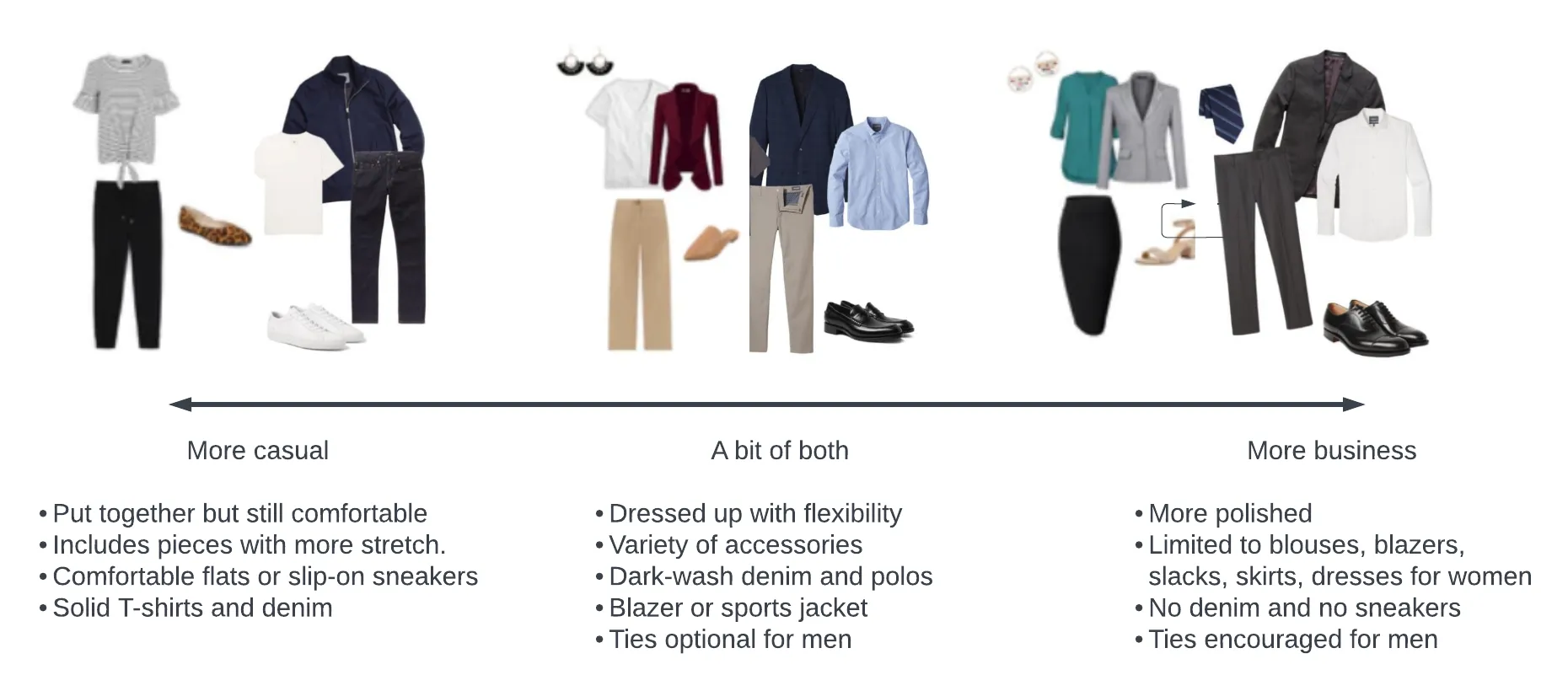
The spectrum ranges from more casual to more business. On the more casual side, you'll find solid T-shirts and denim for men and pieces with more stretch, leggings, and nice flats for women. On the more business side, you'll find sports coats, ties, and dress shoes for men and blouses, blazers, skirts, and dresses for women. We're not fashion experts here at PracticePicnic, but in our experience, when people say business casual, they typically mean something on this spectrum.
Therapists and counselors, depending on the specifics of their situation, will typically want to aim for something on the left side of the spectrum. Something between more casual and "a bit of both." Occasionally, therapists may have to wear something on the right end of the spectrum. For example, if their clientele is particularly business-ey or older, they might want something on the more business end. But in our experience, that's the exception and not the rule.
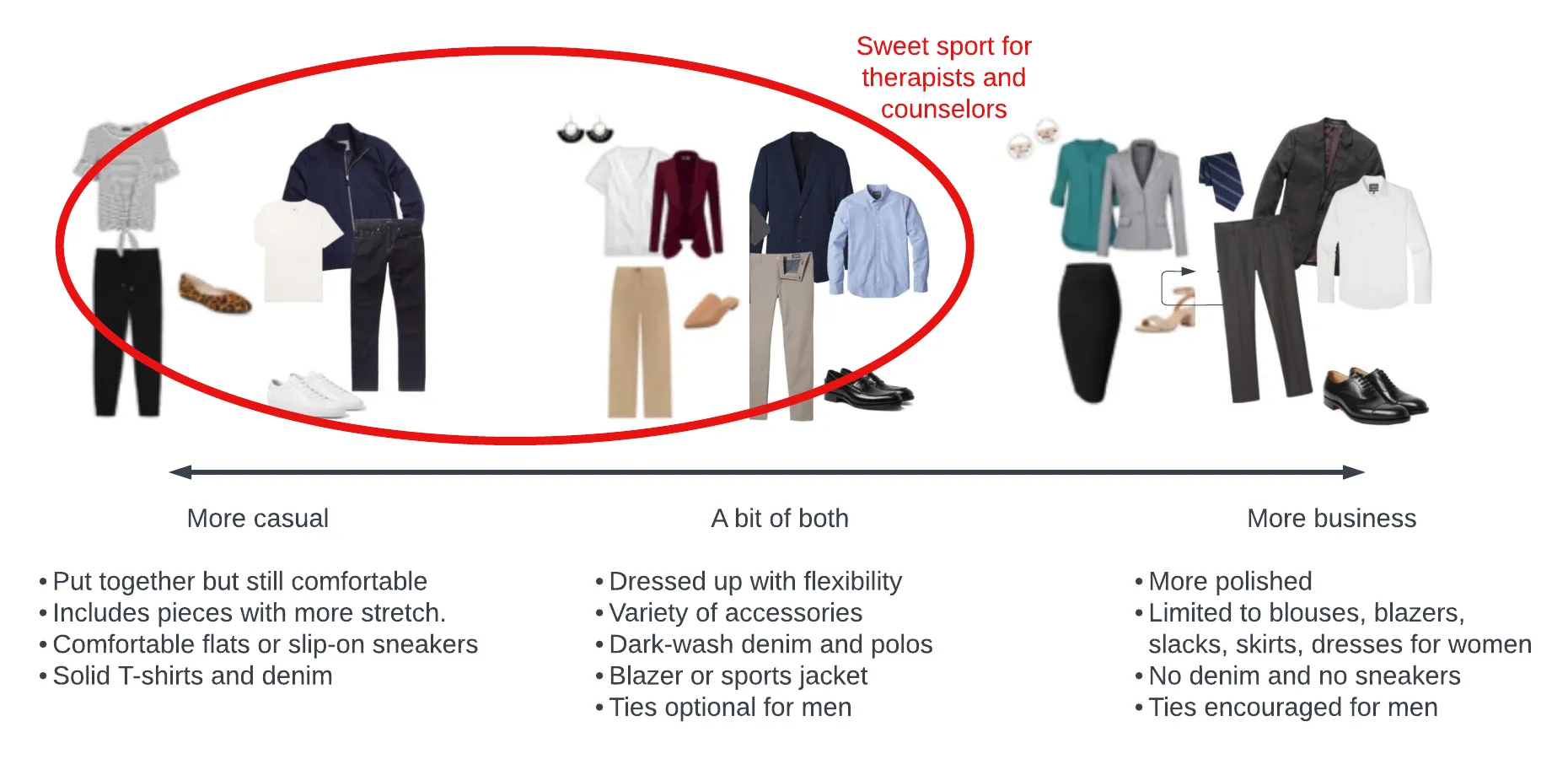
Therapists may occasionally dress entirely outside of this spectrum. For example, if a therapist is trying to portray a very inviting and cozy brand, they may opt for something even more casual than what's on the left end of the spectrum, like a nice plain hoodie or a beanie. For a deeper dive into what exactly business casual means, check out this guide for men, and this guide for women.
Ensure client comfort
If there is one universal rule in therapist fashion, it's this one. Your attire should make your client feel comfortable. This doesn't mean you have to bend over backwards to match your choice of clothing precisely to your client's fashion taste. It just means that you should be mindful of how the client will perceive your clothes and do what you can to ensure they don't feel uncomfortable with them.
Let's look at some examples. Let's say you're a woman who primarily works with college-aged adults. You want your attire to project professionalism but not come off as overly uptight or formal. You don't want to show up wearing a "who farted" T-shirt and sweatpants, nor do you want to show up wearing your most extravagant dress. A reasonable middle-ground choice might be a plain T-shirt of a neutral color, an open-front cardigan, and well-fitted black jeans.
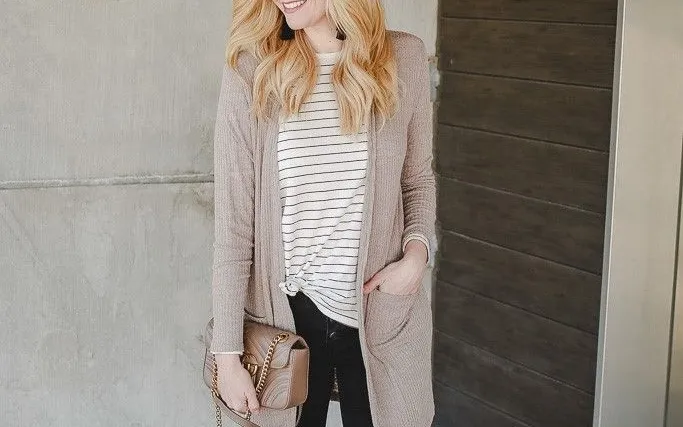
Or maybe you're a man who works primarily with the homeless. You'll want to make sure your outfit doesn't come off as pretentious or snobby while still projecting credibility and competence. This means avoiding overly formal attire and expensive brands likely to make your clients uncomfortable. A reasonable choice in this situation might be a comfortably fitted, button-up shirt of an understated color, classic denim, relaxed-fit jeans, and a pair of brown shoes or boots.
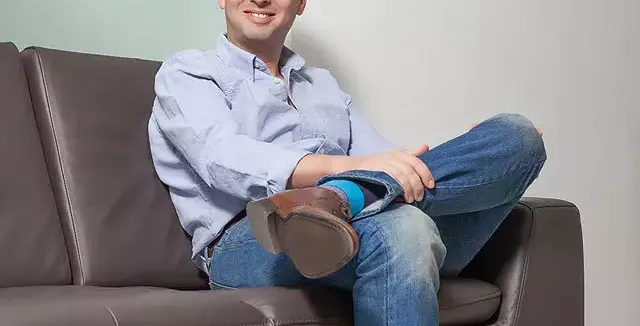
Dress authentically
Fashion is not just about rules, of course. Being real with your clients is important for strengthening the therapeutic alliance, and your choice of clothing is undoubtedly part of that. You want to dress in a way that makes you comfortable, feel fully yourself, and have some fun doing it. For example, don't wear leggings just to seem trendy if they make you uncomfortable, and don't wear blazers just to appear sophisticated if you don't feel like yourself in them.
One great way to show some personality through your attire is with accessories. Watches, necklaces, earrings, bracelets, and our favorite scarves, go a long way in making an outfit more unique and in tune with your identity.
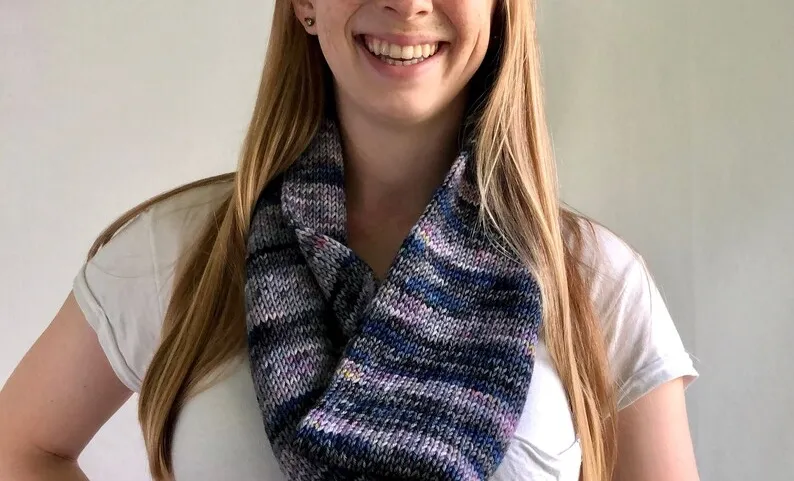
Color palette and emotions
Colors have an incredible ability to impact human perceptions and behaviors in subtle ways. Some colors are hardwired to elicit a visceral reaction in humans when we see them, and some colors we develop an emotional connection to through life experiences. Colors are so important and central to influencing human psychology that design and art schools spend several semesters studying them.
You don't have to become a design scholar to pick the right colored clothes as a therapist. However, we do encourage you to keep these color palettes and their emotional associations in mind the next time you pick an outfit from your closet.
- Soothing and grounded

- Playful and soft

- Uplifting and rejuvenating

- Earthy and sophisticated

Credit for creating these color palettes goes to Tiffany Kenyon. Check out her blog post for more details on colors.
Keep in mind all parties
If you're a couples therapist or work with kids a lot, you likely have more than one person to consider when picking clothes. For example, with couples, you want to dress (to the best of your ability) such that both parties are comfortable. And with kids, you want to balance portraying playfulness and fun to relate to the kid and trustworthiness and respect for the parents. Picking the right outfit gets harder the more people you see at a time, so don't be too hard on yourself. Do the best you can.
Check your workplace rules
While expressing your authentic self is important, you also have to adhere to any dress code requirements set by your employer. Many therapy settings, whether private practices or institutions, have guidelines in place to maintain a professional image. Be sure to check those.
Do the best you can
There is no one-size-fits-all when it comes to your choice of clothing as a therapist. What you wear ultimately will depend on your exact clientele, workplace rules, therapy brand, and personal fashion taste. It's tricky, so just do the best you can!
Try PracticePicnic - The Modern Mental Health EHR
From scheduling to documentation to billing, PracticePicnic has you covered. With our all-in-one EHR, running your mental health practice will be a picnic!
PracticePicnic is the modern EHR for mental health professionals. It gives you all the tools you need to run your practice. Take a look at our features, or our unique business philosophy, The Picnic Way.
